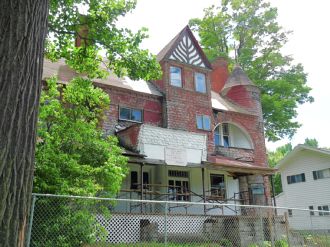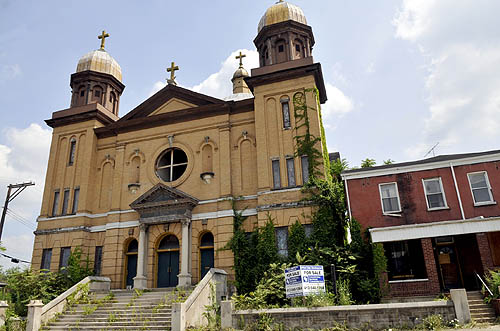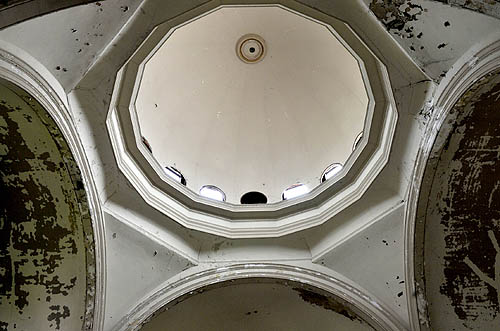
Category Archive: Threatened Historic Resources
-
Jones’ Cresson Home May Avoid Razing
Saturday, November 20, 2010By Patricia Lowry, Pittsburgh Post-GazetteThe Cresson Area Historical Association, which has owned the 14-room, Queen Anne-style house since 1990, has a tentative agreement to sell it to Andrew and Carrie Dziabo, who grew up nearby and live just a few minutes away.
The tentative agreement, reached Friday, appears to have the blessing of Cresson Township supervisors, who heard the couple outline their plans at a township meeting earlier this month.
“We’re still working on it,” said Mr. Dziabo (pronounced zay-bo). “There are issues that need to be worked out, but it’s looking promising.”
The dilapidated house has been under threat of demolition since a Cambria County judge approved its razing in late 2008. Supervisors had told the historical association the house could be torn down after Sept. 30.
A member of the historical group wrote in an e-mail that the house would be sold for a nominal fee, with the new owners also paying the township’s legal expenses incurred during the long court proceedings. Mr. Dziabo referred questions about sale price to the township solicitor, who was unavailable Friday.
Mr. Dziabo grew up a block away from the Jones cottage, in a historic house that also was part of the Mountain House resort grounds. He worked with his father, civil engineer Michael Dziabo, on restoring that house, and the two plan to collaborate on this one.
While Andrew Dziabo, who works for a power company, has admired the Jones house since he was a child, it wasn’t until the historical group offered tours in the spring that he was able to see the interior.
“The house isn’t in as bad shape as I thought,” he said. “It’s actually very sturdy inside. There is some water damage that ate the plaster in a lot of the rooms, but as far as the structure goes, it seems pretty sound and sturdy. The floors don’t even creak.”
The Dziabos intend to restore the exterior and preserve as much of the interior woodwork as they can.
“The whole appeal of it to my wife and me is the character of the Victorian-style home,” he said, adding that its ornate, well-preserved foyer and staircase “would be very easy to restore. It’s just a matter of elbow grease.”
The Dziabos expect to know soon whether the Jones cottage is theirs.
“The township wants to have this issue to bed by the next [supervisors] meeting.”
-
Buying Here: Larimer
Saturday, November 20, 2010By Gretchen McKay, Pittsburgh Post-GazetteOur Lady Help of Christians in Larimer was barely 5 years old when fire ripped through it in 1905, destroying the church at the corner of Meadow and Turrett streets. The Italian immigrants who had guided its construction in 1898, though, were a resolute bunch.
Within a year they’d rebuilt the Baroque-style structure, and until it closed in 1992, Help of Christians served as a center of Italian-American religious and social life, hosting not just Catholic Masses but everything from the annual celebration in honor of St. Agnello Abate to an array of sporting activities for neighborhood kids.
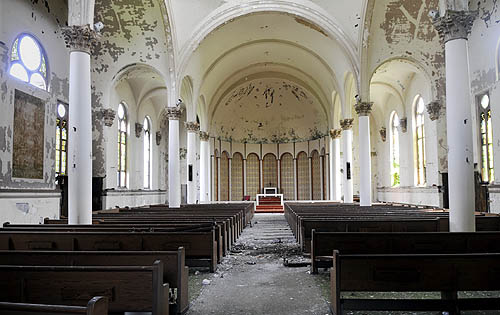
The ceiling and plaster walls have peeling paint at the former Our Lady of Help Christians church in Larimer. J. Monroe Butler II/Post-Gazette
Like many churches in the city, however, its parish aged and dwindled and was merged in the 1990s with five others to form St. Charles Lwanga parish in Lincoln-Lemington. In 1995, the Pittsburgh Catholic Diocese sold the church, which has a banquet hall in the lower level, and adjacent rectory to Heavenly Vision Ministries.
Three years ago, Heavenly Vision put 6513 Meadow St. back on the market, at first quietly through word of mouth, and then last year officially for $169,000 through Coldwell Banker Real Estate’s Fox Chapel office (www.pittsburghmoves.com; MLS No. 838378; 412-963-7655).
 Larimer
Larimer
At a glance- Website: www.city.pittsburgh.pa.us/district9/
- Size: .445 square miles
- Population: 2,602 (2000 census)
- School district: Pittsburgh Public, pghboe.net
- Enrollment: About 28,000
- Average 2010 SAT scores: (Peabody High School) 379 verbal; 410 math; 380 writing
- Taxes for a property assessed at $100,000 *: $2,870; City: $1,080 (10.8 mills); School district: $1,392 (13.92 mills); County: $398 (4.69 mills)
- Wage tax: 3 percent (1 percent to the city, 2 percent to the school district)
- Bet you didn’t know: Originally settled by Germans in the mid-1800s, Larimer was Pittsburgh’s “Little Italy” until the 1960s. It is named for railroad magnate and radical abolitionist General William Larimer, who built a manor home overlooking East Liberty along a path that would eventually become known as Larimer Avenue.
* Includes the Act 50 Homestead Exclusion, which reduces assessed market value by $15,000 for county taxes.Time has not been kind to Help of Christians, which could accommodate up to 1,000 worshippers in the nave and balcony in its heyday in the ’50s and ’60s. The amount of repairs necessary to breathe life back into the property are pretty extensive.
There is no glass in its long, arched windows and holes in the roof. The coved ceiling and plaster walls are peeling paint. Vandals have broken the pews and stolen the pipes from the organ. Carpeting is matted with dust, debris and pigeon feathers. The hand-painted frescoes that brightened the chancel are so badly faded and tarnished you almost can’t tell they were ever there. There’s no heat or water.
“People go in an ooh and aah over the architecture, but it’s a broken structure,” says Realtor Ted Harchick, who shares the “as-is” listing with Dan Boehler.
Adding insult to injury are the many thefts that have stripped the space of most everything of architectural significance. Only a handful of the dozens of original stained-glass windows remain. And it’s only because they’re too heavy to lift that looters also didn’t carry away the marble communion rails in the chancel.
Most heartbreaking is the massive circular window that crowned the front door. Somehow, the robbers managed to sneak the stained glass out of the wood framing in the stealth of night.
Vandals also have trashed the 6,000-square-foot rectory, which during Heavenly Vision Ministries’ tenure housed Family Options Foster Care, in addition to church offices. The property’s current market value is $256,400 ($172,900 for the church and $83,500 for the rectory). Taxes are in arrears on the rectory.
“It’s not for the faint of heart,” admits Mr. Harchick. “We need a risk-taker.”
On the plus side is its location in Larimer. Developments such as Bakery Square, a new “lifestyle center” in the old Nabisco plant on Penn Avenue, are helping to make one of Pittsburgh’s poorest neighborhoods attractive to national retailers and other businesses. UPMC, for instance, is planning to open a technology development center there by the end of the year, and Free People, a hip clothing boutique, follows on the heels of Anthropologie this winter. Next year, a $1.8 million, 14,500-square-foot vocational center funded by the Urban Redevelopment Authority and the Small Business Administration will open not far from the church on Meadow Street.
The Rev. Armenia Johnson, leader of Heavenly Vision Ministries, says she will be very careful in selecting a buyer for the old church.
“We want them to restore it into something that is beneficial and positive for this community,” she says.
In other words, if you’re thinking “brew house” or “night club,” it’s probably not going to fly.
Rev. Johnson, who is now associate pastor of St. James Baptist in Homewood, paid $100,000 the property in 1995. Although the Garfield native did her best to maintain the elegant building, she never had the funding she needed to properly maintain or improve it. So bit by bit, the once grand structure fell into terrible disrepair.
It’s a common fate for churches, which account for a growing number of real estate listings thanks to declining membership and consolidations. According to RealSTATS, a South Side-based real estate information company, 45 churches have changed hands in Allegheny and surrounding counties since January 2009, with sales prices ranging from $5,000 for Ambassador Baptist Church in Ross to $1.1 million for Christian Community Church in Adams.
Occasionally one will make the transition from place of worship to heavenly home. But given the high redevelopment costs, it often takes a grand idea — restaurant, performance hall, multi-unit condo development — and corporate investors to fill such a grand space. CVS, for example, bought the church in Adams. Most are purchased as-is by other religious organizations, or they languish on the market for years.
“You definitely don’t have as many players,” notes Tom Conroy of Howard Hanna Real Estate Services, who has sold so many churches for Hanna’s commercial division that he’s known as The Church Guy.
Mr. Conroy’s current listings include Harvest Baptist Church in New Kensington ($199,000; MLS No. QL102931); St. Michael Church ($250,000; MLS No. QL103962) in Munhall; and St. Mary Magdalene ($159,000; MLS No. QL103653) in Homestead.
Financing, zoning and parking all can be challenges. Many older churches were built in walkable residential areas that prohibit commercial enterprises. Former parishioners add to the difficulty. Even after religious artifacts have been removed and the building is just a building, some stay emotionally attached.
“Significant events take place there,” says Mr. Conroy. “Marriages, baptisms, funerals.”
-
T & T Hardware Closing After 74 Years
Friday, November 19, 2010By Emily Gibb, Pittsburgh Post-Gazette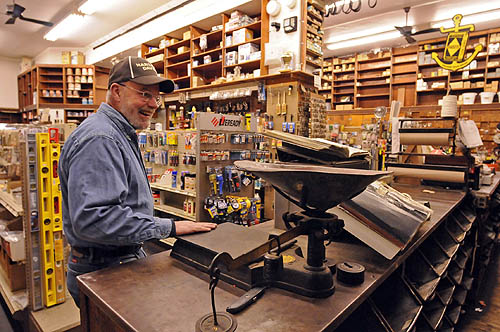
Manager Mark McNally is winding down business at T & T Hardware, a fixture at 2114 East Carson St. on the South Side since 1936. Owned by the Tumas family since its founding, the store has found it impossible to compete with big-box retailers. The scale, which has weighed countless nails and screws for sale by the pound, will remain with the Tumas family. Everything else will be marked down 50 percent Monday morning. Bob Donaldson/Post-Gazette
Pull open the solid wood door with its weathered red paint, walk into T & T Hardware Co. Inc. on the South Side and it’s a bit like stepping back in time.
Wooden shelves line the walls, some all the way to the ceiling, along with rows and rows of little wooden drawers full of screws, nuts and bolts behind a wooden counter along the back. Power tools almost seem out of place in their wood and glass displays.
But next week, after fighting off hard times the last few years, the hardware store fixture on Carson Street begins the process to shut its doors for good.
The “mom and pop” store has too much remaining inventory to liquidate or auction off yet, so beginning Monday, everything is 50 percent off the original price, said manager Mark McNally, 55, of Mount Washington.
They are waiting to see how long it takes to sell most of their inventory to set an exact closing date. This week, they’re just trying to get everything out on the shelves.
Stanley Tumas opened T & T Hardware in 1936. After he retired in the late 1980s, his son, Michael Tumas, took over ownership of the store.
It has stayed in the same spot for the last 74 years, expanding to the side and to the back as the years went on. It was a work in progress until the ’80s, Mr. McNally said.
He says they’ve always had a reputation as the place to go for “odd stuff that no one else has,” like specific plumbing parts, nuts, bolts or screws.
Since he began working at a hardware store in Mount Washington as a teenager and then managing T & T Hardware for the last 15 years, Mr. McNally has seen many changes in the business.
Part of the challenge comes from “big box” stores, like Home Depot. “They’re key why these stores are going,” he said.
Competing with a Lowe’s only five miles away has been difficult.
“It’s just too close. I can show you on my books when they opened,” he said.
Besides competing with large chains, they are competing with the economy as well.
A lot of their business used to come from commercial contractors, but if the contractors don’t have jobs to do, they won’t be coming the hardware store for supplies.
On top of the struggling economy, the South Side is a changing neighborhood.
“For a store like this, the neighborhood has to support it,” he said.
But most people in the neighborhood now rent their houses. Generally, renters aren’t in need of hardware supplies when they can just call their landlord to take care of things.
Saturday used to be the busiest day of the week for a hardware store, Mr. McNally said. Customers who had the day off work would buy their home improvement supplies in the morning. If they were having problems, they would return around noon. If they were really having problems, they would be back again around 3 p.m., Mr. McNally said.
But last year, he started closing on Saturdays — they didn’t have enough weekend business to make it worthwhile anymore.
At one time there were four or five hardware stores just on the South Side, but, he says, “times change. I understand that.”
As Mr. McNally starts a new phase, he has to say goodbye to more than a store and a building.
“The people, without a doubt — that’s what I’m going to miss the most. After 15 years you make good, good friends,” he said.
-
South Side Hardware Store Ends 74-Year Run
By Craig Smith, PITTSBURGH TRIBUNE-REVIEW
Wednesday, November 17, 2010Pittsburgh’s South Side was a different neighborhood in 1936 when Stanley J. Tumas scraped together $800 to open his T&T Hardware store on East Carson Street.
“It was an old ethnic neighborhood. People took pride in that neighborhood,” said his son, Mike Tumas, 59, of Coudersport, Potter County, who has decided to close the store his father started 74 years ago.
The hardware store became a staple of the neighborhood anchored by the nearby J&L Steel mill, he said.
“Guys would get laid off. Their wives would say, ‘You’re painting the house,’ ” Mike Tumas said. “We did well. We did a good business.”
And the business grew over the years. It doubled in size when Stanley Tumas knocked down a wall separating the building.
Father and son worked hard.
“You spent vacations, days off, working at the store,” Mike Tumas said. “That was our life.”
But T&T and other neighborhood hardware stores found it hard to compete with big box chain stores and a changing market. Modernization — fax machines and computers — proved difficult for veteran shopkeepers used to sales receipt books with 50 pages in them, Mike Tumas said.
“My dad’s idea of a fax machine was to hand you a receipt and say, ‘Run this down the corner,’ ” Mike Tumas said.
Three people will lose their jobs when T&T closes before the end of the year. Tumas said he tried to sell the business but found no takers. He plans to sell the building.
“A lot of commercial accounts told me they were leaving Pittsburgh and Allegheny County because of the taxes,” he said. “What commercial businesses are on the South Side anymore?”
Hardware stores used to dot the area — three in Mt. Washington, two in Allentown, four in the South Side.
“We ran longer than most,” said Mark McNally, T&T’s manager.
It was an uphill run.
Home Depot said its sales during the third quarter totaled $16.6 billion, a 1.4 percent increase from the third quarter of fiscal 2009. Lowe’s Cos. Inc. reported sales for the quarter increased 1.9 percent to $11.6 billion, up from $11.4 billion in the third quarter of 2009.
“It’s hard to fight the big guys — they are so big,” said Duquesne University marketing professor Audrey Guskey. “These are family owned, the money stayed here, and the owners poured their hearts and souls into the business.”
The inventory at T&T Hardware, kept in homemade wooden drawers and metal bins, will be liquidated before the store closes, Tumas said.
-
Counties Seek Funds to Refurbish Mon River Ferry
Friday, November 05, 2010Pittsburgh Post-GazetteThe Washington County Commissioners have approved a $971,000 federal grant application to refurbish the Fredericktown Ferry, better known as Fred, which links two tiny towns separated by the Monongahela River.
Fayette County officials signed off on the application last year.
The Port of Pittsburgh Commission recommended repairing the cable driven ferry that shuttles vehicles and passengers across 800 feet of the river between Fredericktown, Washington County, and LaBelle in Fayette County.
The three- to four-minute trip saves motorists from driving about 16 miles to the nearest bridge.
The 60-foot-steel boat can carry six vehicles per trip, and transports about 500 each day.
-
Setback Won’t Deter Move of Historic House
Friday, November 05, 2010By Len Barcousky, Pittsburgh Post-GazettePaul Orange hasn’t given up hope that he will be able to buy and relocate the historic William Smith House in Mercersburg, despite a setback Thursday.
The house is on land owned by the MMP&W Volunteer Fire Co., which acquired the property in 2009 with plans to expand its aging facilities.
The board that oversees the regional fire company opened bids on Thursday for demolishing the 260-year-old structure but did not consider a proposal from Dr. Orange to move it.
Contacted after the meeting, Dr. Orange said he was advised that his offer to pay the fire company $100 for the building, rather than charge for tearing it down, had not been submitted in the right form.
The fire board, however, took no action on the demolition bids it received during its 15-minute meeting. That decision gives him hope that he still can reach an agreement to preserve the house, he said.
Joel Bradnick, a spokesman for the fire board, said the five bids would be forwarded to the fire company’s engineer for evaluation. He described Dr. Orange’s offer as a nonbinding “one-line memo.”
The low bid for demolition was $18,000.
“But why pay $18,000 to knock something down when you have someone willing to give them money to take it away,” Dr. Orange said.
The fire station and the Smith House are next to each other on Mercersburg’s Main Street.
If he is able to reach an agreement to move the house — either with the fire company or with the firm chosen to do the demolition — the next likely step would be to acquire a new location nearby. One possibility is a lot on the other side of Main Street, the site of a closed gas station.
Relocation and land acquisition could cost him as much as $100,000.
The Smith House was built in the 1750s. Constructed as a one-story cottage, it was greatly modified in the 19th and 20th centuries with the addition of a second story and porches.
News that the Smith House might be demolished attracted the interest of a museum in Northern Ireland. The Ulster American Folk Park has been developing plans to rescue the 18th-century first floor of the structure and move it to Europe. There it would become part of a collection of buildings with ties to Scotch-Irish immigration history. Several structures at the outdoor museum were moved from their original sites in southwestern Pennsylvania.
Worries about demolition also resulted in the formation of a small citizens group called the Committee to Save the William Smith House. Committee members have thrown their support behind Dr. Orange’s efforts to move the building.
“I hope we all can come together in a goodwill effort to restore this important piece of history,” said Karen Ramsburg, president of the Smith House committee. “This is America’s house, and I think it could become a real tourism magnet near the Interstate 81 corridor.”
Mercersburg is about 150 miles southeast of Pittsburgh. It is about 10 miles west of the Greencastle exit of I-81.
William Smith, an 18th-century businessman and local magistrate, was one of the leaders of what historians describe as the earliest organized opposition to British rule of its American colonies.
His home was a meeting place in 1765 for mostly Scotch-Irish settlers who organized themselves into armed bands. They formed a local militia after concluding that neither the Quaker-dominated colonial government in Philadelphia nor British officials in London were able to protect them from Indian raids.
William Smith’s brother-in-law, James Smith, was the leader of a group of settlers known as the “Black Boys,” who disguised themselves with paint and Indian clothes. Armed and angry, the Black Boys stopped pack trains traveling from Philadelphia to Fort Pitt that they believed were carrying weapons and ammunition that would end up in the hands of their Native American enemies.
After the British sent troops to nearby Fort Loudon to protect the traders and arrest the Black Boys, the soldiers twice found themselves besieged by the frontier militia.
The shots fired in 1765, 10 years before the Battles of Lexington and Concord, could be called the opening shots of the American Revolution, supporters of the Smith House say.
Dr. Orange describes himself as a history buff. A Westmoreland County native, he is a graduate of Greensburg Central Catholic High School and Saint Vincent College. He has a family medical practice on Route 30, east of Chambersburg.
-
Physician Offers to Move Historic House in Mercersburg
Tuesday, November 02, 2010By Len Barcousky, Pittsburgh Post-Gazette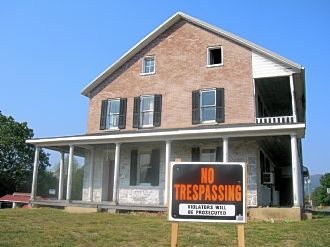
The Smith House is located next to the MMP&W Volunteer Fire Co. The board that oversees the fire company says it needs the land to expand its aging facilities. Len Barcousky/Post-Gazette
A Franklin County doctor has offered to relocate the historic Justice William Smith House in Mercersburg.
“I have a love of history,” Paul Orange said Monday.
He was reluctant to provide too many details of his proposal, but he said he was prepared to cover the costs of moving the two-story structure to a new location. Those expenses, including the cost of acquiring a suitable alternate property, could run as high as $100,000.
Dr. Orange has a family practice along Route 30 in Fayetteville, which is between Chambersburg and Gettysburg. He said he moved to the area in part because of its ties to important events during the Civil War. He is a graduate of Greensburg Central Catholic High School and St. Vincent College. After graduating from medical school at the American University of the Caribbean, he did his residency at Latrobe Hospital.
The Smith House is located next to the MMP&W Volunteer Fire Co. on Mercersburg’s Main Street. The board that oversees the fire company says it needs the land on which the house sits to expand its aging facilities, and it has sought bids for demolition of the building. Its initials stand for Mercersburg, Montgomery, Peters and Warren, which are the communities it serves.
The bids are to be opened Thursday, but the fire company has not said when it will award the contract.
Dr. Orange said he has submitted an offer to move the structure, which would save the fire company the expense of tearing it down.
His proposal has gained the support of a small citizens group, the Committee to Save the William Smith House, which has sought to head off any demolition plans.
“This is an amazing turn just when I thought we were dead in the water,” said Karen Ramsburg, who heads the Smith House committee. “I’m surprised and excited.”
One potential new home for the 18th-century building is the nearby site of a former gas station owned by the First National Bank of Mercersburg.
“The best-case scenario would be to keep the house in its current location,” Ms. Ramsburg said. “Moving it across the street would be the next best thing.”
In 1765, the Smith House was the meeting place for mainly Scotch-Irish settlers who organized themselves into a militia for defense against Indian raids.
Their efforts morphed into attacks on British supply trains and a siege of a nearby British military base called Fort Loudoun. Those early instances of armed resistance took place eight years before the Boston Tea Party and 10 years before the battles of Lexington and Concord.
“It could be said that people in this house provided the spark for the American Revolution,” Dr. Orange said.
Architectural details and property records indicate that the house was built between 1751 and 1759, which includes a portion of the French and Indian War. Porches and a second story were added during the 19th and 20th centuries.
The structure’s connection to the region’s early Scotch-Irish settlers has drawn the attention of an outdoor museum in Northern Ireland.
The Ulster American Folk Park has been working on plans to take apart the 18th-century “historic core” of the stone structure, ship it to Europe and reassemble it outside Belfast.
The folk park already has several other buildings from southwestern Pennsylvania with links to Scotch-Irish immigrants who settled here.
Members of the group seeking to save the house have said relocation to Northern Ireland was a better option than demolition, but they would prefer to have it remain in Franklin County.
Mercersburg is about 150 miles southeast of Pittsburgh.
-
Some Seek to Save Bantam Building
Thursday, October 21, 2010By Karen Kane, Pittsburgh Post-GazetteAs the community prepares to shine a headlight on the historic pairing of the jeep and Butler, efforts have been ongoing to promote the preservation of the site where the jeep was manufactured: the Bantam building off Hansen Avenue in Pullman Center Business Park.
Butler Downtown, an organization committed to the revitalization of the city, coordinated a community drive to raise $25,000 toward the preservation of the building. A representative of AK Steel, which owns the building, said the company was willing to listen to any proposals.
In September, Becky Smith, Main Street manager for Butler Downtown, entered the building in the National Trust for Historic Preservation’s “This Place Matters Community Challenge.” The prize was $25,000 for the site that had the most computer clicks in the challenge.
Of 119 community projects, Butler’s Bantam Building ranked 23rd with more than 600 votes.
“We’re not going to win the money, but this effort raised awareness of the historical significance of the building,” Ms. Smith said.
The winner was a theater project in Austin, Texas.
The building is not being used, and its structural integrity is in question — the roof has a hole in it. Ms. Smith said the prize money could have been used to further the cause for placement on the national historic register or turned over to AK Steel to help with building repair costs.
She said several entities — including Downtown Butler, the Butler County Tourism and Convention Bureau, the Butler County Historical Society and the city of Butler — support the effort to have the building preserved as an important historical place.
The building was constructed in 1899 and 1900 by the Davis Lead Co. After a couple of owners, it ended up in the hands of American Bantam Car Co. in 1929. It was the site of the jeep’s initial manufacture in 1940.
In May, The Young Preservationists Association of Pittsburgh named the Bantam building to its “Top 10 List of Best Preservation Opportunities in the Pittsburgh Area.” The list is designed to encourage investment in historic sites throughout southwestern Pennsylvania.
A spokesman for AK Steel said the practical concerns were standing in the way.
“We have a sense of history ourselves, and we understand the interest in the history of the building; but I don’t know if it’s realistic,” said Alan H. McCoy, vice president for government and public relations.
Mr. McCoy said the building, which hasn’t been used by the company since the 1970s, not only has deteriorated but it is also on a site that is still used by AK Steel.
“It’s not just a matter of transferring ownership of the building. How would they then access it? There are substantial hurdles,” he said.
Still, Mr. McCoy said the company remained open to discussion. “We haven’t said ‘no’ to the idea, and we haven’t said ‘yes’. We just have to see how things unfold.”

